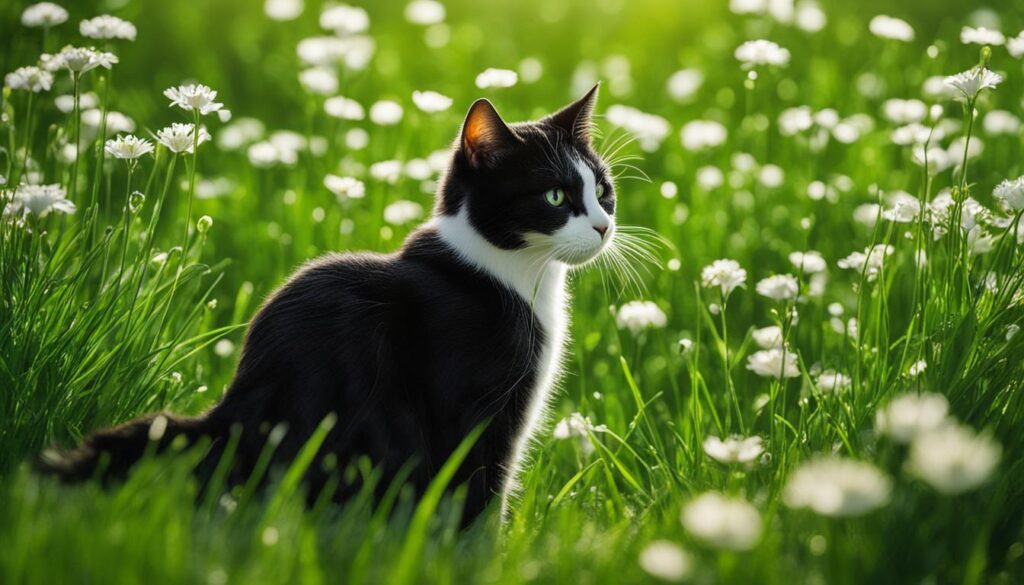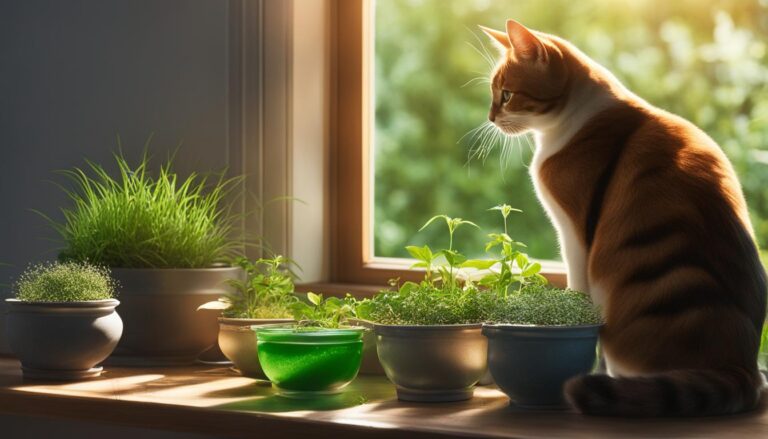Have you ever wondered why your cat has a penchant for nibbling on grass? It’s a behavior that has puzzled many cat owners, but there are actually several reasons behind it. Contrary to popular belief, cats don’t eat grass solely to induce vomiting. In fact, there are numerous benefits to cats eating grass, from nutritional value to environmental enrichment.
Belangrijkste opmerkingen
- Cats eating grass is a natural behavior with various reasons behind it.
- Grass provides essential nutrients and aids in digestion for cats.
- It can also act as a natural toothbrush and help relieve stress in cats.
- However, there are potential dangers, such as toxic plants and ingestion of harmful objects.
- Growing cat-friendly grass indoors or creating a safe outdoor environment can be beneficial for your cat.
Natural Diet for Cats: The Health Benefits of Cats Eating Grass
When it comes to understanding the behavior of cats eating grass, it’s essential to recognize that this is a natural instinct rooted in their ancestral diet. While modern-day domestic cats may primarily rely on commercial cat food, their bodies have evolved to consume a variety of prey in the wild, including small herbivorous animals. This natural diet includes the ingestion of grass and other vegetation, which offers numerous health benefits for felines.
One of the key advantages of cats eating grass is its positive impact on digestion. Grass acts as a natural source of fiber, aiding in the movement of food through the digestive system. This promotes healthy digestion and can help prevent issues such as constipation. Additionally, the chewing action required when consuming grass helps stimulate saliva production, which further assists in the breakdown of food.
Another notable benefit of grass consumption for cats is its potential dental health advantages. The fibrous texture of grass acts as a natural toothbrush, helping to remove plaque and tartar buildup. By doing so, cats that regularly eat grass may experience improved oral hygiene and a reduced risk of dental problems such as gum disease.
| Benefits of Cats Eating Grass |
|---|
| Promotes healthy digestion |
| Acts as a natural toothbrush for dental health |
| Provides environmental enrichment |
| Potentially aids in the expulsion of hairballs |
Additionally, grass consumption can offer environmental enrichment for cats. As naturally curious creatures, cats often enjoy the sensory stimulation provided by chewing on grass. This activity provides mental and physical stimulation, helping to keep them engaged and entertained. Furthermore, the act of eating grass can have a calming effect on cats, thus reducing stress and anxiety in some individuals.
While cats eating grass can bring about significant health benefits, it’s crucial to ensure that the grass they have access to is safe and free from potential hazards. This is particularly important for cats with outdoor access, as they may encounter grass treated with pesticides or ingest other harmful substances. By creating a controlled environment or growing cat-friendly grass indoors, you can provide your feline companion with a safe and enjoyable way to fulfill their natural instincts.
The Dangers of Grass Consumption for Cats
While it is generally safe for cats to eat grass, there are a few potential risks that you should be aware of. One of the main concerns is the quality of the grass your cat consumes, especially if they have access to an outdoor area. It is important to ensure that the grass is free from pesticides or harmful chemicals that can be toxic to your feline friend. Always monitor their behavior and keep a close eye on the environment they are exploring.
Another risk associated with cats eating grass is the inadvertent ingestion of small objects. Cats may nibble on grass and accidentally swallow strings, plastics, or other indigestible materials. This can lead to gastrointestinal obstructions, which can be dangerous and require veterinary intervention. It is important to regularly assess your cat’s behavior and intervene if you notice any abnormal eating habits or signs of distress.
Additionally, certain types of grass, including some varieties that cats are naturally attracted to, can be toxic to them. It is crucial to familiarize yourself with common toxic plants and ensure that your cat does not have access to them. This includes being cautious about the types of grass you allow your cat to consume, especially if you are growing it yourself. Research the specific types of grass that are safe for cats to eat and avoid any that may pose a risk.
The Myth about Cats Eating Grass
“Cats eat grass to induce vomiting.” This is a popular misconception that many people believe to be true. While it is true that cats may sometimes vomit after eating grass, this is not their primary motivation for consuming it. Cats eat grass for a variety of reasons, including obtaining essential nutrients, aiding digestion, and satisfying their natural instincts. So, the idea that cats intentionally eat grass to make themselves vomit is a myth.”
Understanding the potential dangers of grass consumption for cats is essential in ensuring their well-being. By taking necessary precautions, such as providing safe and toxin-free grass, monitoring their behavior, and preventing access to toxic plants, you can help keep your cat safe while still allowing them to enjoy the benefits of grass consumption.
| Potential Risks of Grass Consumption for Cats: |
|---|
| 1. Exposure to pesticides and harmful chemicals |
| 2. Ingestion of small objects or indigestible materials |
| 3. Toxicity from certain types of grass or plants |
How to Safely Introduce Grass into Your Cat’s Diet
If you want to incorporate grass into your cat’s diet, there are a few steps you can take to ensure their safety.
1. Growing cat-friendly grass indoors: Consider growing cat-friendly grass indoors using pet-safe seeds, which are readily available in pet stores or online. This way, you can control the environment and ensure that the grass is free from potential hazards.
2. Creating a safe outdoor environment: If your cat has outdoor access, create a safe and supervised environment to prevent them from accessing grass that may be treated with pesticides or other chemicals.
Indoor Cat Grass Growing Tips
Growing cat grass indoors is a convenient and safe option for providing your cat with a natural source of stimulation and nutrition. Follow these tips for successful indoor cat grass growth:
- Choose a shallow container with good drainage to sow the grass seeds.
- Use organic potting soil as a healthy growing medium.
- Sprinkle the grass seeds evenly over the soil and lightly press them into the surface.
- Place the container in a sunny area and water regularly to keep the soil moist.
- Within a week, you should start to see the grass sprouting, and it will be ready for your cat to enjoy in a few weeks.
By following these guidelines, you can safely introduce grass into your cat’s diet, whether you choose to grow it indoors or provide a supervised outdoor environment. Remember to prioritize their safety by avoiding harmful chemicals and toxic plants.
| Benefits of Introducing Grass | Safe Ways to Introduce Grass |
|---|---|
| Nutritional value | Growing cat-friendly grass indoors |
| Environmental enrichment | Creating a safe outdoor environment |
| Stress and anxiety relief |
Table: Benefits of Introducing Grass and Safe Ways to Introduce Grass to Your Cat’s Diet
The Best Types of Grass for Cats to Eat
Certain types of grass are particularly appealing to cats. When choosing grass for your feline friend, consider these popular options:
- Oat grass: Known for its high fiber content, oat grass is a nutritious choice for cats. It helps with digestion and can aid in the expulsion of hairballs.
- Wheatgrass: Wheatgrass is another cat-friendly grass that offers numerous health benefits. It is packed with essential vitamins and minerals that support overall well-being.
- Barley grass: Similar to wheatgrass, barley grass is rich in nutrients that contribute to your cat’s nutritional needs. It can provide a variety of vitamins and minerals essential for their health.
These grasses are safe for cats to eat and are commonly available as cat grass or pet-safe seeds. You can easily grow them indoors or provide them in a controlled outdoor environment. It’s important to ensure that the grass you offer your cat is free from pesticides or harmful chemicals.

Benefits of Different Grass Types
| Grass Type | Voordelen |
|---|---|
| Oat grass | High fiber content aids digestion and assists in the expulsion of hairballs. |
| Wheatgrass | Packed with essential vitamins and minerals that support overall well-being. |
| Barley grass | Rich in nutrients essential for cat’s health, providing a variety of vitamins and minerals. |
Offering your cat access to these grasses can provide nutritional benefits, environmental enrichment, and potential health advantages. Experiment with different types of grass to see which ones your cat enjoys the most.
How to Grow Grass for Cats
If you want to provide your cat with the benefits of grass consumption, you can easily grow cat grass at home. Follow these simple steps to create a safe and enjoyable environment for your feline friend:
- Choose a shallow container with good drainage to sow the grass seeds.
- Use organic potting soil as a healthy growing medium.
- Sprinkle the grass seeds evenly over the soil and lightly press them into the surface.
- Place the container in a sunny area to ensure proper growth.
- Water the soil regularly to keep it moist, but avoid overwatering.
- In about a week, you should start to see the grass sprouting.
- After a few weeks, your cat can enjoy the freshly grown grass.

By growing grass for your cat, you are providing them with a natural and enriching experience. It allows them to indulge in their instinctual behavior while reaping the health benefits that grass consumption offers.
Creating a safe and controlled environment is key to ensuring your cat’s well-being. Growing cat grass indoors using pet-safe seeds guarantees that the grass is free from pesticides or harmful chemicals that could pose a risk to your cat’s health. If your cat has outdoor access, consider supervising their outdoor time to prevent them from accessing grass that may be treated with pesticides or other chemicals.
Why Is Cat Grass Important?
“Cat grass provides cats with essential nutrients, aids in digestion, and promotes dental health. It also offers sensory stimulation and environmental enrichment for your feline friend.”
Introducing grass into your cat’s routine can be a simple and rewarding process. With just a little effort, you can create a safe and enjoyable space for your cat to indulge in their natural instincts without compromising their well-being.
Conclusie
Understanding why cats eat grass is key to ensuring the health and happiness of your feline companion. Cats are naturally drawn to grass for various reasons, and providing safe access to it can offer numerous benefits.
Cats eating grass is not solely to induce vomiting, as many believe. Grass contains essential nutrients like folic acid and fiber, which aid in red blood cell production, digestion, and the prevention of hairballs. Chewing grass also provides sensory stimulation and environmental enrichment for your curious cat.
By incorporating grass into your cat’s environment, you can support their overall well-being. It aids in digestion, acts as a natural toothbrush, relieves stress and anxiety, and occasionally assists in the expulsion of hairballs or other indigestible material. However, it’s important to be aware of potential dangers, such as pesticides, harmful chemicals, and toxic plants. Take necessary precautions, like avoiding these hazards and monitoring outdoor access, to keep your cat safe.
So, whether you choose to grow cat-friendly grass indoors or create a supervised outdoor space, providing access to grass can satisfy your cat’s natural instincts and offer a source of nutrition, environmental enrichment, and potential health benefits. Pay attention to your cat’s preferences and needs, and enjoy watching them indulge in their natural behavior.




